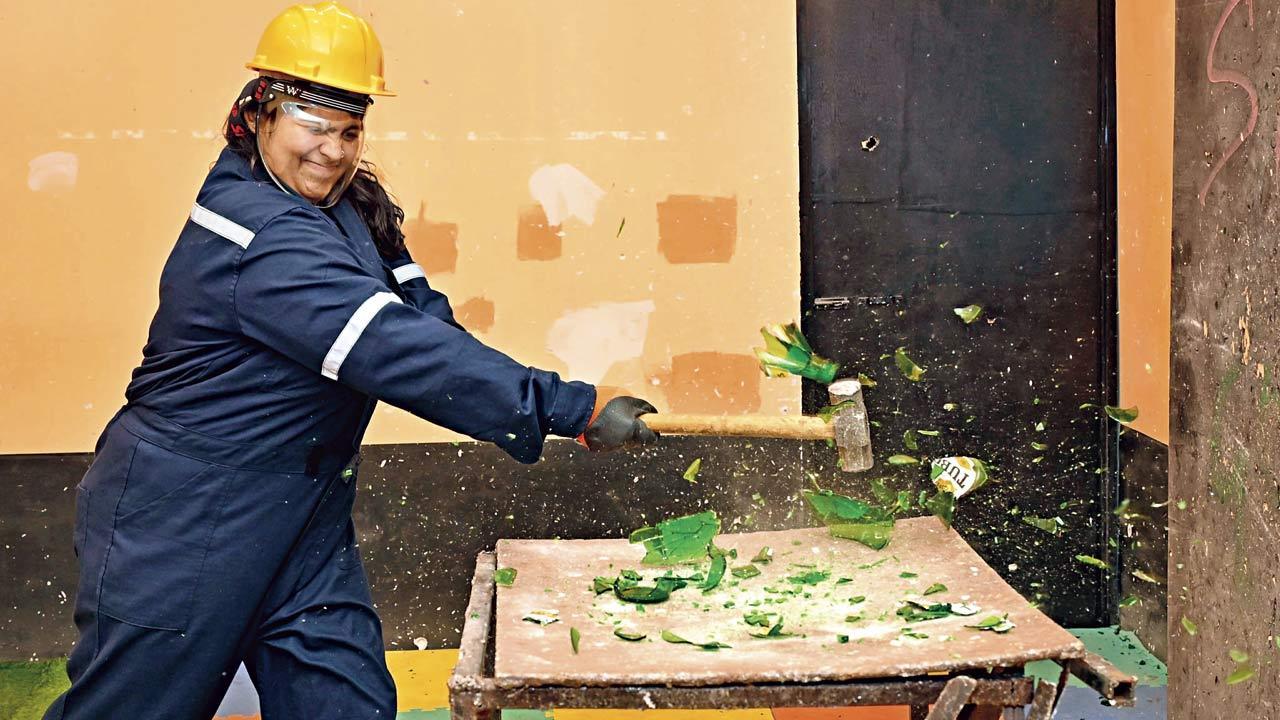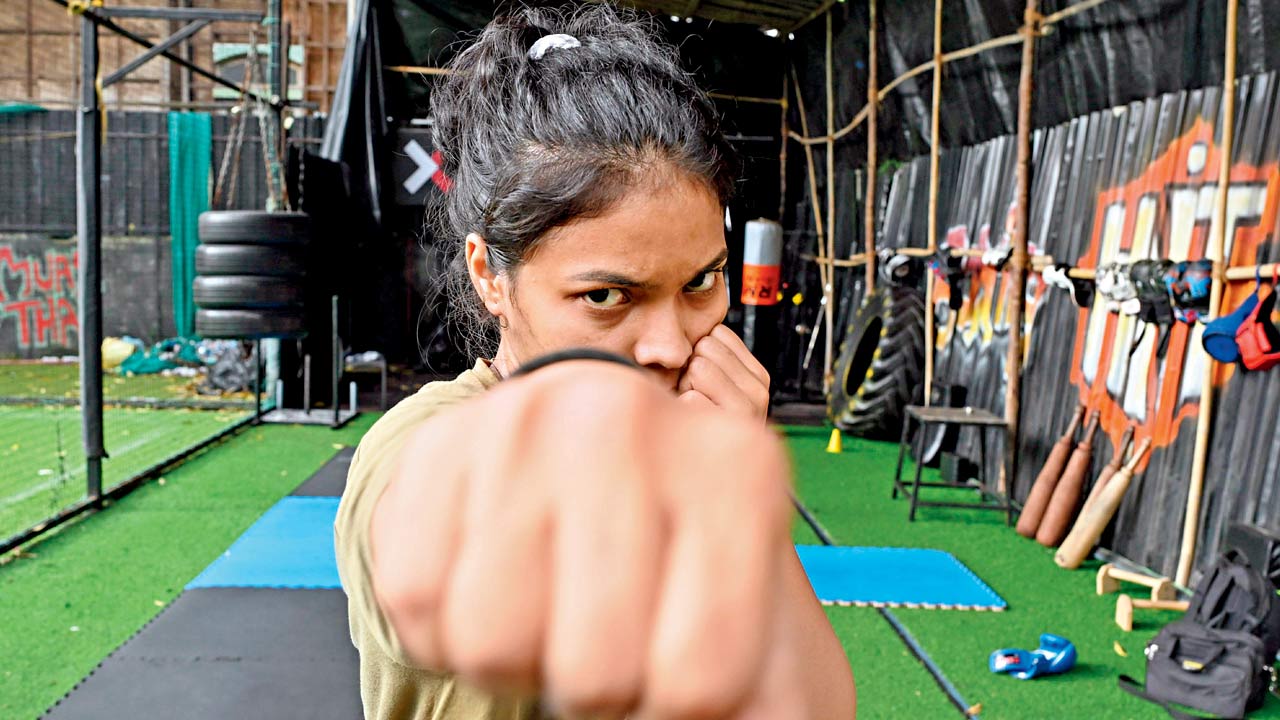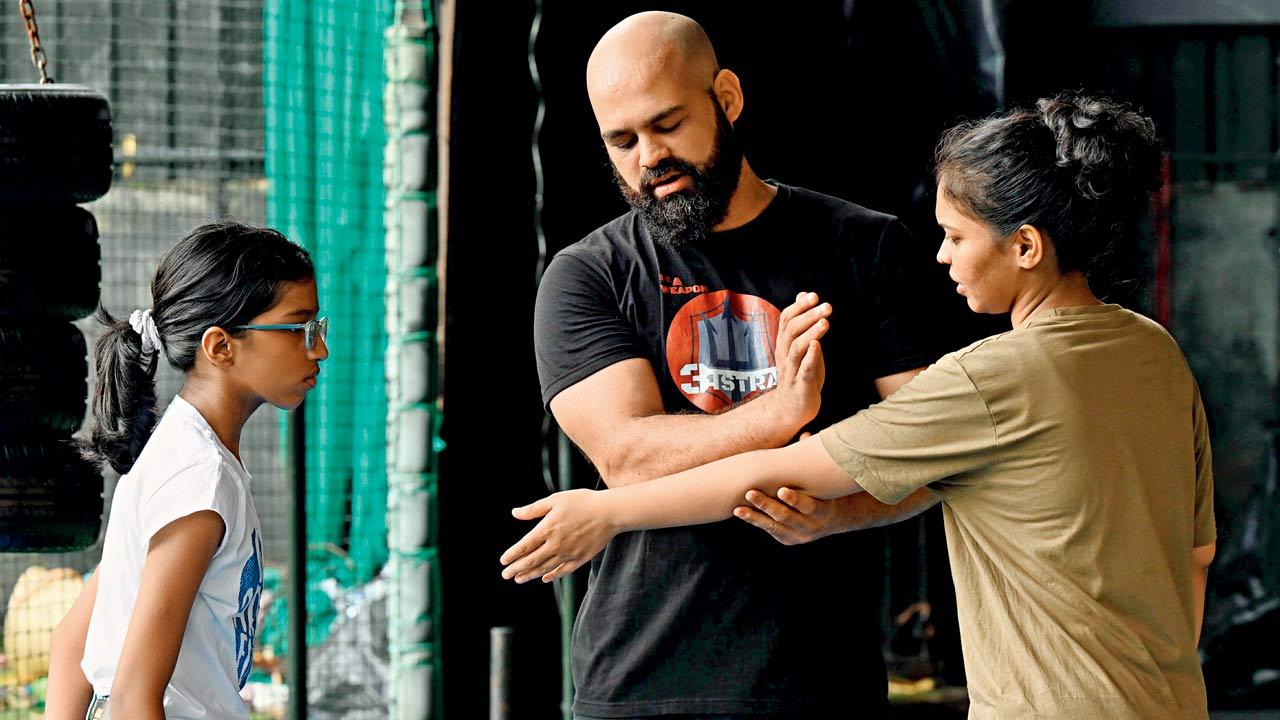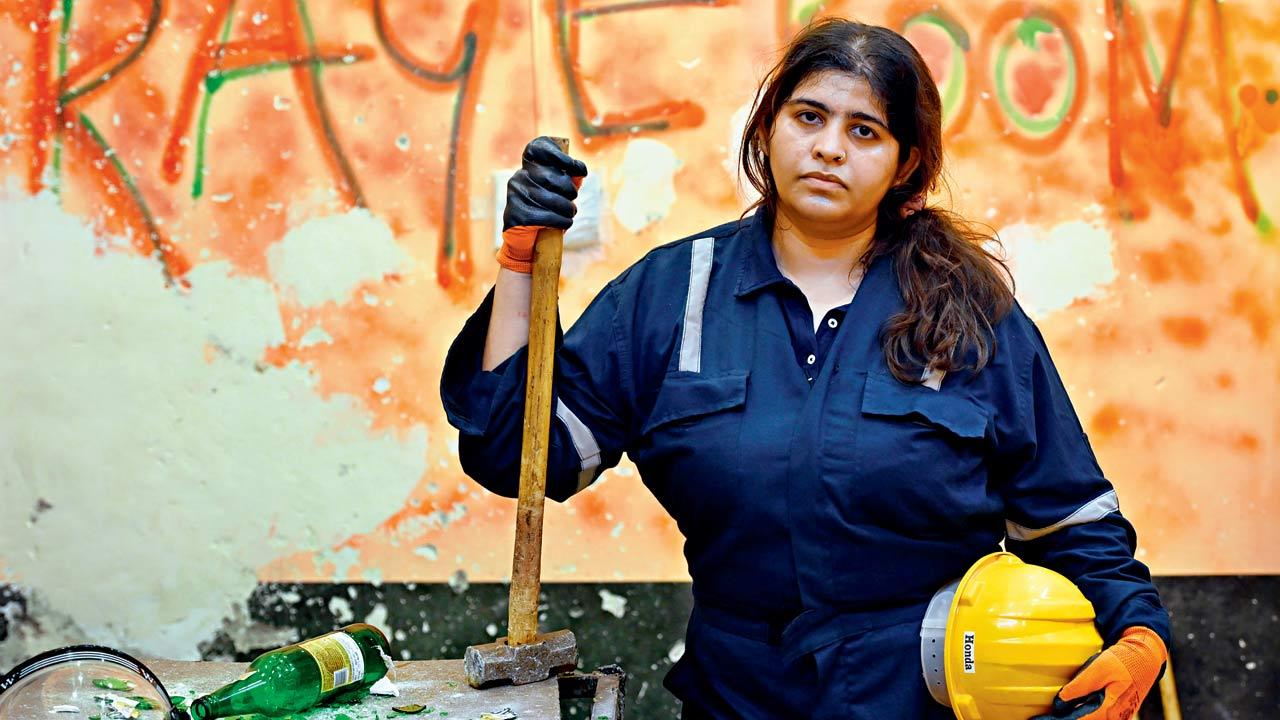Indian women, even as young as teenagers, are getting angrier, thanks to early puberty, dysfunctional families and childhood trauma. The only way out could be to break things, and learn self-defence

Shivani Sharma, 30, lets out her fury at the Rage Room in Andheri West. Sharma has battled anger since school, and uses social media as an outlet, venting over a myriad of social injustices. Pic/Satej Shinde
Sannidhi Pai was just five years old when she yanked her cousin’s arm out of the shoulder socket after he teased her. It was entirely unintentional, but the vehemence of her rage shocked her parents and they promptly sent her for anger management therapy. Now 26, Pai, who has spent a lifetime in therapy, finds that she’s never been angrier.
She switches on the news to hear about the rape and murder of a doctor on night duty at a Kolkata hospital. It’s a case that hits close to home, as the Dahisar resident is pursuing a Masters degree in forensic psychology at Bournemouth University, UK, where she is specialising in sexual abuse and child violence. Day in and day out, she studies accounts of such violence and converses with convicted sexual abusers as part of her research. When she brings up the issue in conversations, there’s always someone who responds with “not all men”. “This makes me even angrier,” says Pai.
Much has been written about righteous female fury against sexual violence and systemic injustice. This wrath was celebrated as a catalyst for change when the #MeToo movement began. But where do women put their rage over everyday stresses? The weariness from managing jobs and households, often with little to no help from partners; childhood trauma from dysfunctional families; romantic relationships turned sour or job interviews gone wrong—the list doesn’t end.
 A rager for life, Sannidhi Pai has found a healthy outlet for pent-up frustration through Krav Maga
A rager for life, Sannidhi Pai has found a healthy outlet for pent-up frustration through Krav Maga
Sometimes, it’s just inconveniences of life—minor and big—that add up and cause an explosion. “I had to return to India halfway through my course because of visa issues. After I returned, something as small as a cup not in its place would result in me erupting. Mera haath uth jaata hain; it’s an automatic reflex, I have never struck anyone. If I was a man, no one would blink twice. It’s normal, or even cool to be an angry young man, but as a woman, it’s unthinkable to express anger or aggression,” rues Pai.
According to a survey in 2022 by analytics firm Gallup, over 40 per cent Indian women are angry now, compared to 27 per cent a decade ago. On the other hand, rage among male respondents in the same study has stayed steady at 30 per cent.
In a 2016 study by Lovely Professional University with 100 participants, 30 per cent women reported high levels of aggression, compared to 22 per cent of men.
Indian women are getting angrier, but with aggression usually perceived as a male emotion, there is no space for them to express their fury, which is often trivialised or even shamed. With no safe outlet, the anger can explode into violence, warn experts.
 Pai and Shravani Lad learn a technique from Krav Maga practitioner Anurag Rane at his class in Borlivli. Pics/Satej Shinde
Pai and Shravani Lad learn a technique from Krav Maga practitioner Anurag Rane at his class in Borlivli. Pics/Satej Shinde
Last week, the video of a 14-year-old schoolgirl being thrashed by her classmates—a gang of girls— went viral on social media. They punched her, kicked her and dragged her by her hair on the street in Versova, all over some “teasing” and clique politics.
“They were minors, so they were counselled based on the norms of the Juvenile Justice Board. The girls were then handed over to their families,” says DCP (Zone IX) Raj Tilak Roshan.
As vicious as the attack was, what shocked people more was that the perpetrators were all girls. Mumbai Police officials say they have observed an increase in violent acts by women in recent years. Even law enforcement officers are on the receiving end of this wrath at times, with multiple instances across the nation of women thrashing cops. A viral video from an August 19 incident in UP shows a woman chasing and hitting a cop with a stick after he intervened in a scuffle between two groups. Two days before that, a Pune woman had to be deboarded from a flight after she attacked co-passengers and bit a CISF constable.
 Ananya Shekhar, Seema Hingorrany, Ananya Shetty, Masha Arabi and Shinie Antony
Ananya Shekhar, Seema Hingorrany, Ananya Shetty, Masha Arabi and Shinie Antony
“We have encountered several situations where women have lost their temper with officers. If the argument involves a male officer, he is required to handle the situation cautiously and request the assistance of a female officer. The situation gets more challenging when the woman is intoxicated and starts verbally abusing the officers out of anger and frustration, particularly during nakabandi,” said a senior Mumbai Police officer.
Seema Hingorrany, a Bandra-based clinical psychologist, says she has observed a rise in aggression among girls as young as 10-12 years, particularly in the last five years. “Earlier, I would rarely get cases of schoolgirls acting out in class. But in the last five years, I have seen a spate of such cases.”
“I had one client who removed the blades from her sharpener and pointed it at a boy who was bullying her. She said she had told her parents about it, but nobody addressed her problem. The biggest problem is that parents don’t talk to their children calmly to try and understand what the problem is. When a girl acts out, parents’ reaction is much harsher—they tell her ‘you’re a girl, behave like one’,” she says.
 Shivani Sharma feels lighter after hammering out her frustration on glass bottles at the Rage Room in Andheri West. Pic/Satej Shinde
Shivani Sharma feels lighter after hammering out her frustration on glass bottles at the Rage Room in Andheri West. Pic/Satej Shinde
She adds that in many cases, the cause is hormonal. “Puberty is hitting girls as early as 10 or 11 years of age now. They don’t understand what is happening to their bodies, why they have mood swings, why they are putting on weight. When they get teased about it, they lash out because they won’t know how to process these emotions.”
In dysfunctional families, the child can pick up aggression at home, observing shouting matches or violence between their parents. Hingorrany says, “When the parents have anger problems and resolve all their issues by shouting, you will usually see children modelling that behaviour. When the childhood trauma remains untreated, they grow into women who are quick to retaliate. It’s an extreme defence mechanism.”
Masha Arabi, 30, a public relations executive and artiste manager living in Mangaluru, recalls growing up in a loud household, where all disagreements ended in shouting matches. “There were a lot of times my family members would drag me into their fights and I would end up yelling too. I grew up feeling like I had to show anger to get people to listen to me. My parents used to walk on eggshells around me. When my father passed away last year, I carried regret over my rage for months. Now I have learned to control my tongue. I went for therapy, I do a lot of yoga,” she says.
Shivani Sharma, 30, an Andheri-based canine behaviourist and rescuer, has battled rage since her school years. “I was bullied over my weight and appearance. [To protect myself] I became a bully too. I wasn’t doing well academically, so that added to my rage. I started losing friends because of my anger,” she recalls.
As an adult, the tiniest things can tip her over the edge. “Marketing calls, WhatsApp forwards, traffic—I find myself yelling over everything. My sister is embarrassed to go out with me because I’m always clashing with people. I have a strained relationship with my parents. I’ve distanced myself from people when they’ve irritated me,” she says.
Her profession exposes her to stressors on a daily basis. “I’ve been working in animal rescue for 10 years. My day revolves around animals that are abused left, right and centre. I feel overwhelmed, and that compassion fatigue has caused me to get angry at any and everything,” says Sharma.
Social media is her one outlet, says the self-professed keyboard warrior, who raids the comment section to vent her ire over a myriad of social injustices. Each time, though, she emerges from her online “rage fest” feeling more infuriated.
Therapy has not helped as much she had hoped, she says. We try a different tactic. After our first phone call, we meet her at the Rage Room in Andheri West for 30 minutes of fury-fuelled smashing of objects. Initially, the sheer violence of it feels unnatural to Sharma, who has spent her entire life trying to control her fury, not unleash it. “I was trembling after the first swing. I didn’t realise that releasing my anger could feel this good,” she says.
“The Rage Room,” says founder Ananya Shetty, “is a safe, non-judgmental space where emotions are celebrated rather than suppressed. Women often face societal pressure to maintain grace, so a private space to vent freely is incredibly appealing.”
The numbers don’t lie: 70 per cent of their clients are women. “Women have always had reasons to be angry. What’s changing is their willingness to challenge societal norms and take control of their lives, leading to more visible expressions of that anger,” says Shetty.
Why, then, is society so shocked by female rage and aggression? “History is full of angry men; angry women have had to adjust their expression to suit society, as also to achieve best results,” says Shinie Antony, author of Eden Abandoned: The Story of Lilith. In her book, the titular character—Adam’s first wife who turns into a vengeful, child-eating demon—is the personification of female rage.
“Male anger is seduction, his peacock dance. He gets angry to protect his woman, his country, the planet. Without his anger there’d be no war, no victor. Female anger is an oxymoron. Women are taught how to speak and laugh softly, silently... Aggressive men are considered an asset in the workplace, aggressive women could be seen as hysterical and problematic… The truth is women as a gender are angrier than men, given the past treatment of them. A scary man is the norm, but a truly scary woman can undo society. Which is why any instance of female rage unsettles everyone,” she adds.
Even in popular culture such as films, whether it’s Rekha in Khoon Bhari Maang or Smita Patil in Mirch Masala, raging women are usually depicted in stories of vengeance, fighting injustice—only that seems to give them a right to anger. It’s hard to imagine a Bollywood film like Animal—in which Ranbir Kapoor plays a misogynistic, violent man with daddy issues—centred on a badly behaved woman instead.
Javed Akhtar, one half of the veteran screenwriting duo Salim-Javed credited with the “angry young man” cult in Hindi cinema, recently commented on how Bollywood lacked such depictions of women until very recently.
Newer films such as Qala and Andhadhun have finally ventured into the moral grey area with female characters, wreaking unprovoked death and destruction.
Ananya Shekhar, a counselling psychologist specialised in working with children and adolescents in Chennai, says it’s important to teach children to express their emotions in a healthy way, rather than suppress them. “If you’ve seen the movie Inside Out, they’ve beautifully expressed how anger is just another emotion. So why is it considered ‘not normal’? How are children being taught to express this emotion? Are there any lessons on emotion management at schools? What media are kids being exposed to? How do adults around them express these emotions? All children and adults need to be taught how to manage and express their emotions and the impact of their behaviours on others.”
Without a healthy mechanism to regulate anger, teenage girls often turn the aggression inwards, resorting to self-harm, says Shekhar.
In Borivli-based martial arts practitioner Anurag Rane’s vocabulary, aggression is not a bad word, but a survival skill. He holds regular sessions to teach women and girls Krav Maga, an Israeli self-defence system in which surprise and aggression are two central tenets.
“When faced with a threat, your response is either fight, flight or freeze. Most women freeze because society has not taught them to hone their aggression. Girls are taught to be demure, this has been hammered into them for generations. In class, we run simulations of an attack and try to make it as convincing as possible and motivate the students to tap into their aggression,” says Rane.
He had a former student who had grown up witnessing domestic violence in her family and was averse to any kind of aggression, even in class. But through repeated practice, he taught her that not all aggression is bad and she eventually came out of her shell.
“When you break a bottle, it can either crumble into pieces or break into sharp shards that hurt others. Women who have gone through traumatic events either develop low confidence or have a lot of bottled up rage. Krav Maga helps both. It is physically and emotionally demanding, and a positive way for women to spend all their pent-up anger,” says Rane.
It is in Rane’s class that Sannidhi Pai finally found her release, after years of anger management. And it is here that Shravani Lad, 13, found a safe space to let out all her frustration in the two months since her joining the class. “I get angry when I hear of women being raped. Sometimes I get angry when adults [at home or in school] blame us kids for things we didn’t do. But as girls, we are taught to respect our elders and not argue with them. Krav Maga is a positive way for me to dump all my anger,” says the teen.
“Aggression is a form of pent-up energy. It can come out in an outburst, which is unhealthy for me and those around me, or it can come out in a healthy outlet like Krav Maga,” says Pai.
Well-tuned aggression can be a boon in the office too, providing women with the courage to ask for a promotion, or confront that team member who always tries to undermine others. “I was too timid at my former workplace and people took advantage of that. I feel women need to put up an aggressive front at the workplace,” says Masha Arabi. After all, as the saying goes, “nice girls don’t get far”.
Inputs by Faizan Khan
Also Read: My daughter understands why I need her live location: Navi Mumbai mom after Badlapur school case
 Subscribe today by clicking the link and stay updated with the latest news!" Click here!
Subscribe today by clicking the link and stay updated with the latest news!" Click here!










